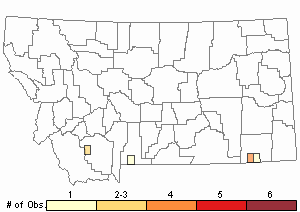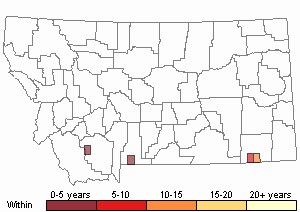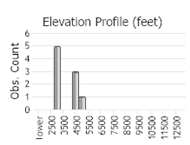View in other NatureServe Network Field Guides
NatureServe
Montana
Utah
Wyoming
Idaho
Wisconsin
British Columbia
South Carolina
Yukon
California
New York
Red-rim Melania - Melanoides tuberculatus
State Rank Reason (see State Rank above)
A conservation status rank is not applicable because this species is not a suitable target for conservation activities as a result of being exotic or introduced to the state.
General Description
The red-rim Melania shell has a high slender spire and decorative colors that doesn't resemble any other native snail in the west. An elongate, conical shell with as many as 10-15 slightly convex whorls, usually light brown marked with rust colored spots (Daniel et al 2018). An operculum is present and has coarse striations spirally up the shell (India Biodiversity Portal 2018).This exotic snail is introduced in 20 states in the US. Size: Average shell length: 20–27 mm; 80 mm maximum (India Biodiversity Portal 2018)
Diagnostic Characteristics
The red-rim Melania shell has a high slender spire and decorative colors that doesn't resemble any other native snail in the west. An elongate, conical shell with as many as 10-15 slightly convex whorls, usually light brown marked with rust colored spots (Daniel et al 2018).
Range Comments
Native Range: Found wide-ranging and common in Africa and the eastern Mediterranean countries and throughout India, Southeast Asia, Malaysia, and southern China, north to the Ryukyu Islands of Japan, south and east through many of the Pacific islands to Northern Australia.
Introduced Range: United States. U.S. introductions confirmed in Oregon, California, Nevada, Idaho, Montana, Wyoming, Arizona, Colorado, New Mexico, Texas, Louisiana, Florida, North Carolina, and Hawaii (Anderson, 2004).
For maps and other distributional information on non-native species see:
Nonindigenous Aquatic Species Database from the U.S. Geological Survey
Invasive Species Habitat Tool (INHABIT) from the U.S. Geological Survey
Invasive Species Compendium from the Centre for Agriculture and Bioscience International (CABI)
EDDMapS Species Information EDDMapS Species Information
Observations in Montana Natural Heritage Program Database
Number of Observations: 10
(Click on the following maps and charts to see full sized version)
Map Help and Descriptions
Relative Density

Recency



 (Observations spanning multiple months or years are excluded from time charts)
(Observations spanning multiple months or years are excluded from time charts)
Migration
Mostly Sedentary. Only move between waterbodies by human intervention
Habitat
Red-rim melania is a freshwater benthic species living on the bottom of permanent waters, from small spring streams to vast lakes. This species is rarely found in temporary water bodies, but may resist a broad spectrum of environmental conditions (Pointier et al., 2005). We have a record of a shell found in the Powder River (SE corner of Montana) that may have come in from WY and this a large-turbid prairie stream.
Food Habits
Typically, snails are scrapers of algae and diatoms on hard substrates or vegetation. This species feeds on microalgae and detritus (dead plants and animals).
Ecology
Red-rim melania is a freshwater benthic species living in and on the bottom sediments of permanent waters, from small springs to vast lakes (e.g. Lake Victoria), but it can also inhabit brackish waters (Wingard et al. 2008). Laboratory studies have shown it can survive hypersaline environments up to 45 ppt. (Wingard et al. 2008; Silva and Barros 2015). Optimum temperature range is from 18-32° Celsius (A. Mitchell, personal communication).
Reproductive Characteristics
Red-rim melania can breed sexually or parthenogenically (development of embryos occur without fertilization) and brood young internally (India Biodiversity Portal 2018). Under favourable conditions, females transfer 1-64 fertilized eggs to a brood pouch for hatching. Juvenile snails are 1.2-2.2 mm in size at birth (India Biodiversity Portal 2018).
Management
Potentially increasing populations in Montana (increase of >10%). We found a lone empty Melania snail shell on the bank of the Powder River in 2011 (see photos). This is the only other river system besides the Beaverhead River where this species has been reported.
Contact information for Aquatic Invasive Species personnel:Montana Fish, Wildlife, and Parks Aquatic Invasive Species staffMontana Department of Natural Resources and Conservation's Aquatic Invasive Species Grant ProgramMontana Invasive Species Council (MISC)Upper Columbia Conservation Commission (UC3)Stewardship Responsibility
Threats or Limiting Factors
Due to their wide-ranging habitats in their native range, they would likely survive if introduced into many waterbodies in Montana.
Research has been conducted to determine the snail's lethal water temperature, about 50° Celsius (120° Fahrenheit), for the disinfection fishing gear and research equipment which may inadvertently spread snails to uninfested waters (A. Mitchell, personal communication). Therefore, zebra mussel disinfection methods in MT should also work on preventing spread of this introduced snail.
References
- Literature Cited AboveLegend:
 View Online Publication
View Online Publication Anderson, T.K. 2004. A review of the United States distribution of Melanoides tuberculatus (Muller, 1774), an exotic freshwater snail. Ellipsaria 6(2): 15-18.
Anderson, T.K. 2004. A review of the United States distribution of Melanoides tuberculatus (Muller, 1774), an exotic freshwater snail. Ellipsaria 6(2): 15-18. Pointier, J.P., M. Yong, and A. Gutierrez. 2005. Guide to the Freshwater Molluscs of Cuba. ConchBooks: Hackenheim, Germany. 120 pp.
Pointier, J.P., M. Yong, and A. Gutierrez. 2005. Guide to the Freshwater Molluscs of Cuba. ConchBooks: Hackenheim, Germany. 120 pp.
- Web Search Engines for Articles on "Red-rim Melania"
- Additional Sources of Information Related to "Snails / Slugs"





